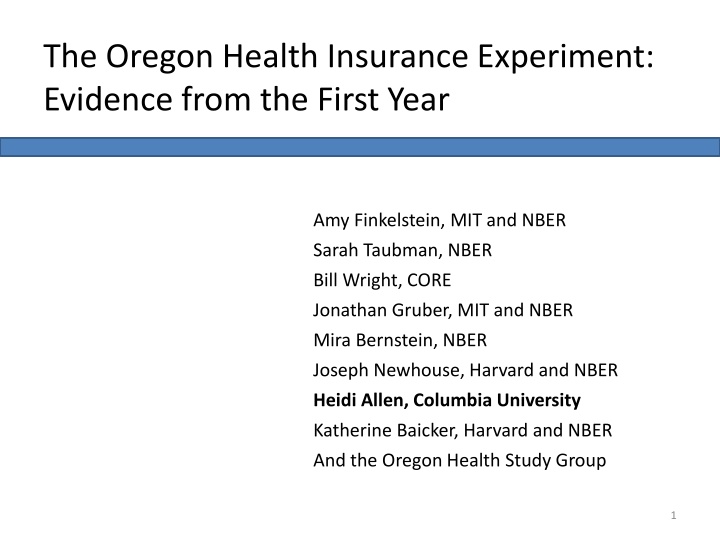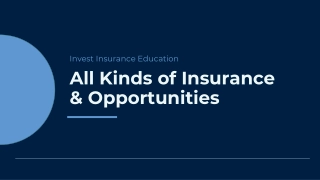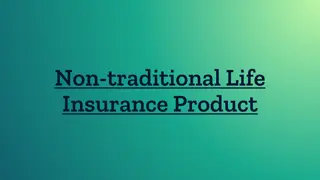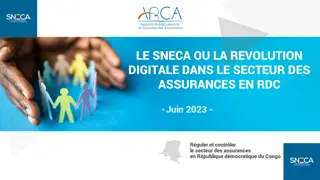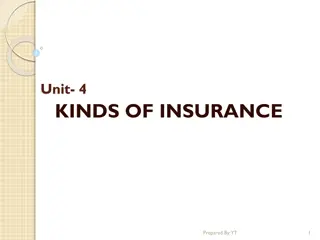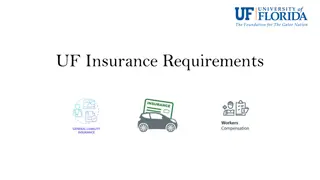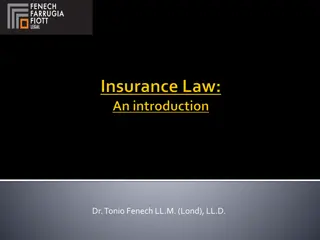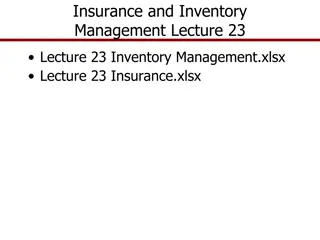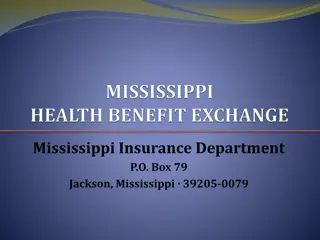The Oregon Health Insurance Experiment: Evidence from the First Year
The Oregon Health Insurance Experiment was a randomized study evaluating the effects of expanding public health insurance access for low-income adults. This study examined the costs, benefits, and impact on health care utilization, financial strain, and overall health outcomes. Through a comprehensive analysis, it aimed to provide insights into the potential advantages of such expansions.
Download Presentation

Please find below an Image/Link to download the presentation.
The content on the website is provided AS IS for your information and personal use only. It may not be sold, licensed, or shared on other websites without obtaining consent from the author.If you encounter any issues during the download, it is possible that the publisher has removed the file from their server.
You are allowed to download the files provided on this website for personal or commercial use, subject to the condition that they are used lawfully. All files are the property of their respective owners.
The content on the website is provided AS IS for your information and personal use only. It may not be sold, licensed, or shared on other websites without obtaining consent from the author.
E N D
Presentation Transcript
The Oregon Health Insurance Experiment: Evidence from the First Year Amy Finkelstein, MIT and NBER Sarah Taubman, NBER Bill Wright, CORE Jonathan Gruber, MIT and NBER Mira Bernstein, NBER Joseph Newhouse, Harvard and NBER Heidi Allen, Columbia University Katherine Baicker, Harvard and NBER And the Oregon Health Study Group 1
The Question To Expand or Not to Expand? What are the costs and benefits of expanding access to public health insurance for low income adults? Costs - Health care access & utilization Benefits Financial Benefits - Health According to the Kaiser Family Foundation, Georgia has over a million uninsured adults below 138% of Federal Poverty Level 2
Why Another Study? What can OHIE tell us that other insurance studies haven t? Existing evidence is more limited than you d think Does Medicaid really make people sicker? Gold standard research in health policy is very difficult 3
In 2008, Oregon Held a Health Insurance Lottery Oregon Health Plan Standard Oregon s Medicaid expansion program for poor adults - Comprehensive coverage, minimal cost-sharing Opened waiting list for 10,000 new slots in 2008 Randomly selected names for access to coverage Study Design Evaluate the effects of public insurance using lottery as RCT Massive data collection effort Answers specific to context, but some broader lessons 4
Overview of Approach 1. Experimental Design. Evaluate the effects of public HI on utilization, health, & other outcomes using lottery as RCT. 2. Use an intent-to-treat (ITT) approach to account for the imperfect take-up into coverage. This means we compare based on selection, not insured vs uninsured. 3. Compare outcomes between selected and non-selected individuals over time. 4. Extrapolate the actual effect of insurance coverage (similar to treatment on the treated, or ToT) from the ITT model to estimate the total effects of gaining insurance. 5
Expected Change in 1 Year This analysis used MAIL SURVEY & ADMINISTRATIVE DATA to assess one-year findings within several domains: Access & Use of Care Is access to care improved? Do the insured use more care? Is there a shift in the types of care being used? Financial Strain How much does insurance protect against financial strain? What are the financial implications? Health What are the short-term impacts on physical & mental health? 6
Closer Look: Mail Survey Data Fielding Protocol ~70,000 people, surveyed at baseline & 12 months later Basic protocol: Three-stage mail survey protocol, English/Spanish Intensive protocol on a 30% subsample included additional tracking, mailings, phone attempts - Done to adjust for non-response bias Response Rate Weighted response rate=50% Non-response bias always possible, but response rate and pre-randomization measures were balanced between treatment & control 7
Closer Look: Administrative Data Medicaid records Pre-randomization demographics from list Enrollment records to assess first stage (how many of the selected got insurance coverage) Hospital Discharge Data Probabilistically matched to list, de-identified at OHPR Includes dates and source of admissions, diagnoses, procedures, length of stay, hospital identifier Includes years before and after randomization Other Data Mortality data from Oregon death records Credit report data, probabilistically matched and de- identified for analysis 8
Results The paper details one-year findings in three domains, drawing from a combination of different data sources: Health and Use of Care Hospital discharge data Mail surveys Financial Strain Credit reports Mail surveys Health Mortality from vital statistics Mail surveys Not reflected here (coming soon): Biomarker Data Qualitative Data ED Administrative Data 10
Access & Use of Care Overall, utilization and costs went up. Relative to controls . 30% increased probability of an inpatient admission 35% increased probability of an outpatient visit 15% increased probability of taking prescription medications No change in ED usage Total $777 increase in average spending (a 25% increase) In return for this spending, those who gained insurance were . 35% more likely to get all needed care 25% more likely to get all needed medications Increased use of preventative services 11
A Closer Look at Prevention and Quality Adherence to recommended preventative care: Cholesterol checked: 63% vs. 74% Ever had a diabetes test: 60% vs. 69% Mammogram in last 12 months: 30% vs. 49% PAP test in last 12 months: 41% vs. 59% Quality measures: Usual place of care: 50% vs. 84% Have a personal provider: 49% vs. 77% Satisfied with quality of care: 71% vs. 85%
Financial Strain Overall, reductions in collections on credit reports were evident 25% decreased probability of a medical collection Those with a collection owed significantly less No decrease in bankruptcy Household financial strain related to medical costs was mitigated. Owing $$ for medical expense: 60% vs. 42% Borrowing $$ or skipping other bills: 36% vs. 21% Any out of pocket medical expenses: 56% vs. 36% 13
Health Overall, big improvements in self-reported physical, mental health 25% increased probability of good, v. good, excellent health 10% decrease in probability of screening for depression Physical health measures are open to several interpretations Improvements here are consistent with findings of increased utilization, better access, and improved quality BUT in our baseline surveys, we saw results appearing shortly after coverage (~2/3rds magnitude of the full results). This may suggest increase is in perceptions of well being. 14
Peace of Mind I have an incredible amount of fear because I don t know if the cancer has spread or not. A lot of times I wanted to rob a bank so I could pay for the meds I was just so scared People with cancer either have a good chance or no chance. In my case it's hard to recover from lung cancer but it's possible. Insurance took so long to kick in that I didn't think I would get it. Now there is a big bright light shining on me.
Future Measures Biomarker/in-person health data Blood pressure, cholesterol, & C-reactive protein HbA1c levels (blood sugar control) Body mass index scores Longer, more sensitive depression screen Pain scale assessments Detailed health & health behavior data (diet, smoking, etc) Qualitative interview data Mechanisms for positive or null findings Administrative data ED data 16
Discussion One year after expanded access to insurance, we find that Medicaid really made a difference. Increases in hospital, outpatient, and Rx use Improvements in measures of quality and access Increased use of preventative screenings Reductions in financial strain, medical collections Significant improvement in physical and mental health It didn t pay for itself (by immediately reducing ED visits, for example), but the benefits were considerable. 17
Did We Learn Anything New? Compared to other national surveys, and non-experimental variation in our sample, we found smaller increases in health care use and bigger effects on health. Consistent with the theory of adverse selection 18
Broader Policy Lessons No evidence of private insurance crowd-out Our population is very similar to the target PPACA Medicaid expansion population Caveats Oregon s system wasn t likely strained by the expansion Mandate may reach a different population Oregon s population isn t fully representative Longer-run effects may differ 19
Acknowledgements OHS RECEIVED SUPPORT FROM: PARTNERS Robert Wood Johnson Foundation Sloan Foundation California Health Care Foundation MacArthur Foundation Smith-Richardson Foundation National Institutes of Health (NIH) Centers for Medicare & Medicaid Services (CMS) HHS Assistant Secretary for Planning & Evaluation (ASPE) Providence: CORE NBER/Harvard/MIT OHPR/Oregon Health Authority OHREC Portland State University www.oregonhealthstudy.org 20
Extra Slides 21
Types of Data 1. Phase 1 (Mail Surveys) 70,000 people statewide, baseline & 12 months later 2. Phase 2 (Biomarker & Health Interview Data) 13,200 people within 30 miles of Portland Conducted 1-2 years after randomization 3. Phase 3 (Administrative Data) Medicaid enrollment records Statewide Hospital discharge data, 2007-2010 Mortality & credit report data, 2007-2010 Metro ED data from 13 hospitals 2007 - 2010 4. Phase 4 (Qualitative Data) Over 750 in-depth personal interviews 22
Sample 89,824 unique individuals on the list Sample exclusions (based on pre-randomization data ONLY) --Ineligible for OHP Standard (out of state address, age, etc) --Individuals with institutional addresses on list Could have improved power by bounding sample with other data (i.e., income), but would have corrupted randomization Final sample: 74,922 individuals (66,385 households) --29,834 treated individuals (surveyed 29,589) --45,088 control individuals (surveyed 28,816) 23
Empirical Framework We pre-specified and published our analytic plan prior to analyzing the data. We produced two types of equations (more detail available in the full paper): Reduced Form effect of lottery selection Also known as Intent to Treat (ITT) --the difference between groups, preserving integrity of randomization. Instrumental Variable (IV) effect of insurance coverage Also known as Treatment on Treated (ToT) -- what the treatment effect would have been had everyone in the treatment group gained coverage. 26
Assumptions This approach does rely on some assumptions, which we test in more detail in the full paper: Reduced form Intent to Treat Was the lottery truly random? Did people who won or lost the lottery differentially respond to surveys? IV Treatment on Treated The lottery had no effect except via its impact on insurance coverage Winning or losing effects? Increased participation in other programs? 27
Empirical Framework: Reduced Form = + + + + y LOTTERY X V 0 1 2 3 ihj h ih ih ihj LOTTERY indicator for whether household h selected X denotes covariates correlated with treatment probability Household size indicators In survey data: Survey wave (and interactions with HH size) V denotes (optional) covariates Survey data: none Admin data: lottery draw; pre-randomization y 28
Empirical Framework: IV Estimation Two-stage Least Squares (2SLS): = + + + + y INSURANCE X V 0 1 2 3 ihj ih ih ih ihj With the first stage equation: = + + + + INSURANCE LOTTERY X V 0 1 2 3 ihj ih ih ih ihj Similar multiple inference adjustment 29
Inference Over Multiple Outcomes Group outcomes into domains (e.g. health, financial strain) Summary measure: average standardized treatment effect across all outcomes j in domain J: 1 J j 1 j J j Individual estimates ( 1j s) Per-comparison (usual) p-values Family-wise p-values (Westfall-Young) 31
Results: Access & Use of Care Gaining insurance resulted in increased probability of hospital admissions, primarily driven by non-ED admissions. CONTROL RF Model (ITT) IV Model (ToT) P-Value Any hospital admission 6.7% +.50% +2.1% .004 --Admits through ED 4.8% +.2% +.7% .265 --Admits NOT through ED 2.9% +.4% +1.6% .002 SOURCE: Hospital Discharge Data. Overall, this represents a 30% higher probability of admission, although admissions are still rare events. 32
Results: Access & Use of Care Gaining insurance resulted in better access to care and higher satisfaction with care (conditional on actually getting care). CONTROL RF Model (ITT) IV Model (ToT) P-Value Have a usual place of care 49.9% +9.9% +33.9% .0001 Have a personal doctor 49.0% +8.1% +28.0% .0001 Got all needed health care 68.4% +6.9% +23.9% .0001 Got all needed prescriptions 76.5% +5.6% +19.5% .0001 Satisfied with quality of care 70.8% +4.3% +14.2% .001 SOURCE: Survey data. 33
Results: Access & Use of Care Gaining insurance resulted in increased adherence to recommended preventive care. CONTROL RF Model (ITT) IV Model (ToT) P-Value* Ever had cholesterol checked 62.5% +3.3% +11.4% .0001 Ever had diabetes test 60.4% +2.6% +9.0% .0001 Mammogram in last 12 mos 29.8% +5.5% +18.7% .0001 PAP test in last 12 mos 40.6% +5.1% +18.3% .0001 SOURCE: Survey data. *NOTE: All p-values take into account that we estimated multiple equations within each domain of interest. 34
Results: Financial Strain Gaining insurance resulted in a reduced probability of having medical collections in credit reports, and in lower amounts owed. CONTROL RF Model (ITT) IV Model (ToT) P-Value Had a bankruptcy 1.4% +0.2% +0.9% .358 Had a collection 50.0% -1.2% -4.8% .013 --Medical collections 28.1% -1.6% -6.4% .0001 --Non-medical collections 39.2% -0.5 -1.8% .455 $ owed medical collections $1,999 -$99 -$390 .025 SOURCE: Credit report data. 36
Results: Financial Strain Survey measures suggest that gaining insurance significantly mitigated household financial strain. CONTROL RF Model (ITT) IV Model (ToT) P-Value Owe $ for medical expenses 59.7% -5.2% -18.0% .0001 Borrowed $ or skipped other bills to pay medical bills 36.4% -4.5% -15.4% .0001 Any out of pocket medical expenses 55.5% -5.8% -20.0% .0001 SOURCE: Survey data, six month recall period. 37
Results: Health Self-report measures showed significant health improvements one year after randomization. CONTROL RF Model (ITT) IV Model (ToT) P-Value Health good, v good, excellent 54.8% +3.9% +13.3% .0001 Health stable or improving 71.4% +3.3% +11.3% .0001 Depression screen NEGATIVE 67.1% +2.3% +7.8% .003 CDC Healthy Days (physical) 21.86 +.381 +1.31 .018 CDC Healthy Days (mental) 18.73 +.603 +2.08 .003 SOURCE: Survey data. 38
Comparison to RAND Compare Medicaid experiment (no ins Medicaid) to RAND (least most generous coverage) Increased health care use smaller than expected? 25% (vs 45%) increase in spending 55% (vs. 75%) increase in number of outpatient visits 30% (vs. 30%) increase in probability of hosp admission Self reported health increase bigger than expected? RAND: no evidence of impact of insurance generosity on adult self-reported general health or mental health. 39
